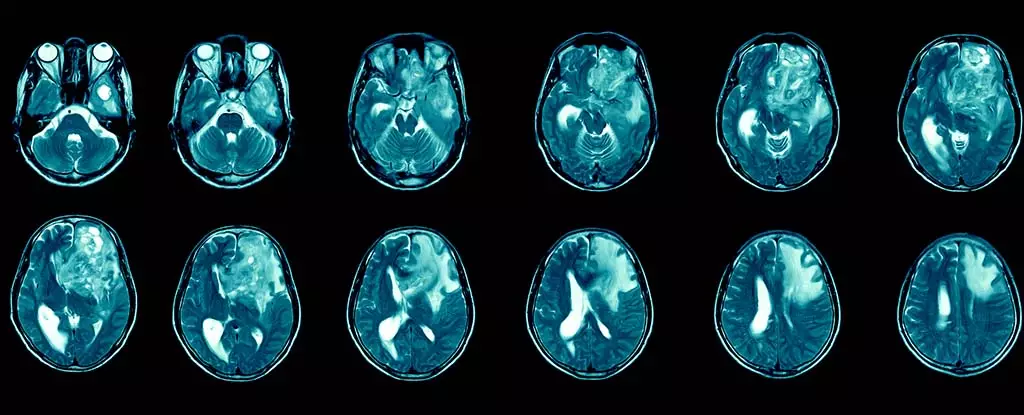Glioblastoma multiforme (GBM) stands as a formidable adversary within the world of oncology. As the most prevalent and lethal type of brain cancer, it presents a daunting challenge for patients and healthcare providers alike. The prognosis for those diagnosed with GBM is tragically stark: the average survival time ranges from just 12 to 15 months, with a mere 6.9% of patients reaching the five-year milestone following their diagnosis. This heartbreaking reality underscores the urgent need for innovative treatment solutions, particularly as symptoms associated with glioblastoma—such as debilitating headaches, seizures, and profound cognitive and personality alterations—further reduce the quality of life for those affected.
GBM belongs to a wider family of tumors known as gliomas, which arise from glial cells in the brain and spinal cord. Recognized globally as a grade 4 tumor by the World Health Organization, glioblastoma exhibits aggressive growth patterns and a unique ability to infiltrate surrounding brain tissue. In the UK alone, an estimated 3,200 new glioblastoma cases are diagnosed each year, contributing to the overall annual report of 12,700 brain and central nervous system tumors. Globally, the incidence rate is around 3.2 to 4.2 cases per 100,000 individuals, culminating in roughly 150,000 new diagnoses worldwide every year. This statistic further cements GBM’s position as a significant public health concern.
Traditionally, the management of glioblastoma involves a triad of interventions: surgical resection, radiation therapy, and chemotherapy. Unfortunately, these approaches often yield only transient results. The inherent resilience of glioblastoma to standard therapies can be attributed to several factors, including the tumor’s adeptness at evading immune responses and the formidable blood-brain barrier, a protective shield that limits the effectiveness of many pharmaceuticals. Consequently, the prospect of glioblastoma recurrence is high, with tumors frequently reestablishing themselves post-surgery. This continuing cycle not only exacerbates the challenges faced by patients but also complicates treatment strategies for oncologists.
In the face of such daunting challenges, immunotherapy has emerged as a beacon of hope in the treatment landscape for glioblastoma. By harnessing the body’s immune system to specifically target cancer cells, researchers are beginning to explore promising strategies that could redefine treatment paradigms. While immunotherapy approvals for other cancers—such as melanoma, breast, and lung cancers—have been met with optimism, glioblastoma remains an area ripe for exploration. Ongoing research indicates potential for administering immunotherapy through innovative routes, such as directly into the cerebrospinal fluid, a method aimed at enhancing drug delivery efficacy to the tumor site.
Although the road ahead is paved with complexities, the enthusiasm within the scientific community is palpable. Global research efforts are underway to develop immunotherapeutic strategies specifically tailored to glioblastoma. My personal journey over the past two decades has involved delving into immune modulation amid cancer and chronic infections. My recent endeavors focus on bridging existing knowledge regarding the immune response with glioblastoma treatment, with an emphasis on circumventing obstacles that inhibit drug accessibility to tumors. This collaboration among researchers from diverse disciplines fosters a richer, more innovative approach to tackling this dreadful disease.
While the prospect of effective immunotherapies is tantalizing, significant hurdles remain. Currently, no immunotherapy has received approval for clinical use against glioblastoma. Furthermore, immune-related side effects can pose serious risks, including potential organ inflammation and brain swelling. Careful deliberations around delivery methods are crucial, as non-invasive administration through an injection in healthcare settings is markedly preferable to invasive surgical options. Addressing these concerns is fundamental to paving the way for clinical acceptance and patient safety in immunotherapy.
Despite the stubborn challenges posed by glioblastoma, the landscape of potential treatment options continues to evolve. As the body of research grows, fueled by increasing funding and interest, the hope for viable immunotherapy treatments feels closer than ever. Through collaborative efforts, innovation, and unwavering determination, researchers are collectively striving to improve outcomes for glioblastoma patients. It is this spirit of resilience and hope that inspires continued exploration in the relentless fight against one of the most challenging cancers known to humankind.


Leave a Reply